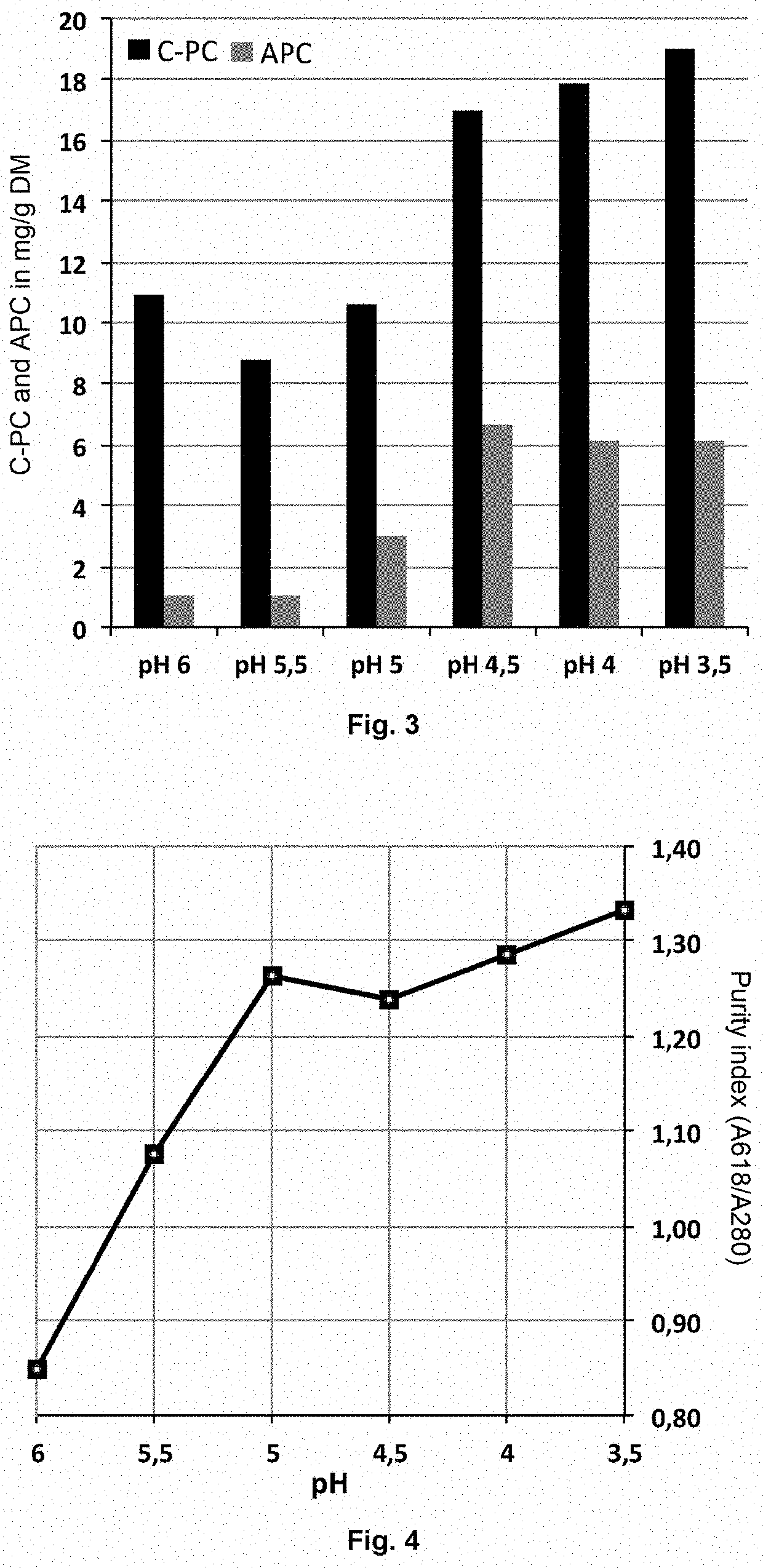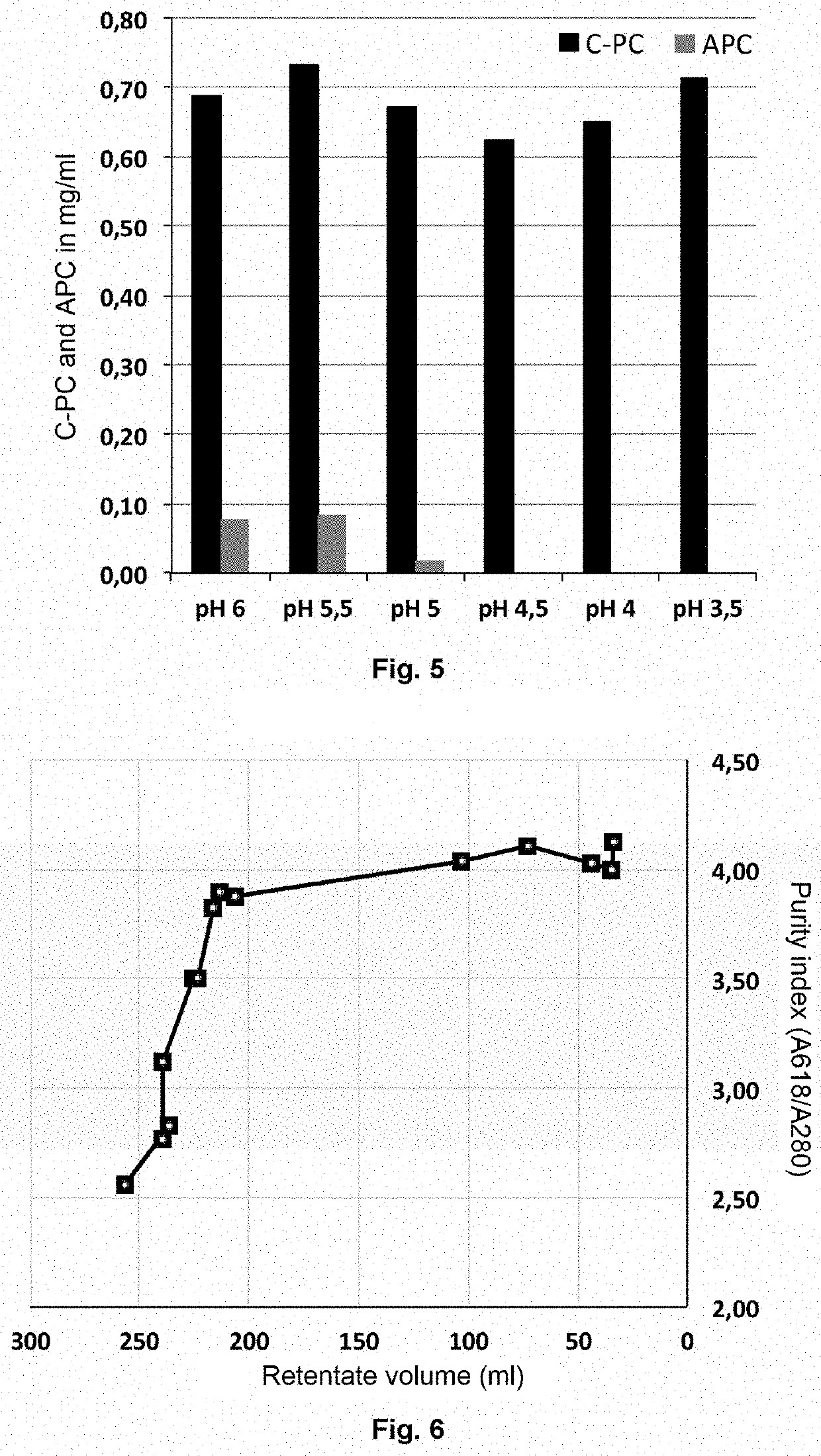Purification of phycobiliproteins
a technology of phycobiliproteins and purification methods, applied in the field of new purification processes of phycobiliproteins, can solve the problems of difficult industrial application, high cost of chromatographic methods, and only partially removed micelles
- Summary
- Abstract
- Description
- Claims
- Application Information
AI Technical Summary
Benefits of technology
Problems solved by technology
Method used
Image
Examples
example 1
ion by Acid Precipitation on Fresh Cells
[0110]A Galdieria sulphuraria cell fermentation must centrifuged and rinsed with an equivalent volume of water is mechanically ground to release the phycobiliproteins in an aqueous phase at pH 6. The ground material is acidified in 0.5 pH unit steps by adding citric acid. At each level, a sample of the mixture is taken and then centrifuged for 10 min at 11,000 g. The supernatant containing the phycobiliproteins is collected and the purity index measured by measuring the ratio of absorbance at 618 nm to the absorbance at 280 nm with a spectrophotometer (Amersham Biosciences Ultra Spec 2100 Pro).
[0111]It is clear that the lower the pH, the higher the purity index (FIG. 1). This increase in the purity index reflects a decrease in contaminating proteins in the supernatant, while C-PC remains predominantly in the supernatant. Due to its resistance to acid pH there is no substantial loss of C-PC content in the supernatant (FIG. 2). Surprisingly, all...
example 2
ion by Acid Precipitation on Freeze-Dried and Rehydrated Cells
[0113]A Galdieria sulphuraria cell fermentation must centrifuged and rinsed with an equivalent volume of water is mechanically ground to release the phycobiliproteins in an aqueous phase at pH 6. The ground material is then freeze-dried. The freeze-dried dry matter is suspended in a volume of water equivalent to the initial volume of the must and then acidified in 0.5 pH unit steps by adding citric acid. At each level, a sample of the mixture is taken and then centrifuged for 10 min at 11,000 g. The supernatant containing the phycobiliproteins is collected and the purity index measured by measuring the ratio of absorbance at 618 nm to the absorbance at 280 nm with a spectrophotometer (Amersham Biosciences Ultra Spec 2100 Pro).
[0114]As previously described in Example 1, we can see an increase in the purity index correlated with a decrease in pH (FIG. 4). In this case, too, acidification also results in better separation of...
example 3
ion and Concentration of C-PC by Tangential Filtration
[0115]The crude extract after acid precipitation and centrifugation is filtered on a hollow-fibre tangential filtration module. Filtration through this mesh removes some of the proteins other than C-PC and thus increase the purity index (FIG. 6). The purity index that can be achieved by this method approaches the values normally obtained by much more complex methods involving biphasic extractions, or precipitation with ammonium sulphate, or even chromatography methods (Soresen et al., 2013; Cruz de Jesus et al., 2006). In parallel with the purification process, this filtration step removes the water from the C-PC extract (FIG. 7) and facilitates the subsequent drying of the product.
PUM
| Property | Measurement | Unit |
|---|---|---|
| molar ratio | aaaaa | aaaaa |
| molar ratio | aaaaa | aaaaa |
| densities | aaaaa | aaaaa |
Abstract
Description
Claims
Application Information
 Login to View More
Login to View More - R&D
- Intellectual Property
- Life Sciences
- Materials
- Tech Scout
- Unparalleled Data Quality
- Higher Quality Content
- 60% Fewer Hallucinations
Browse by: Latest US Patents, China's latest patents, Technical Efficacy Thesaurus, Application Domain, Technology Topic, Popular Technical Reports.
© 2025 PatSnap. All rights reserved.Legal|Privacy policy|Modern Slavery Act Transparency Statement|Sitemap|About US| Contact US: help@patsnap.com



